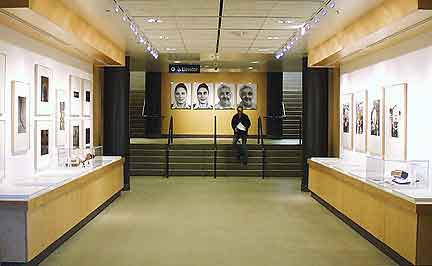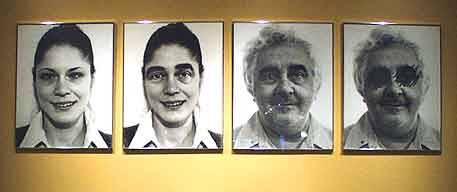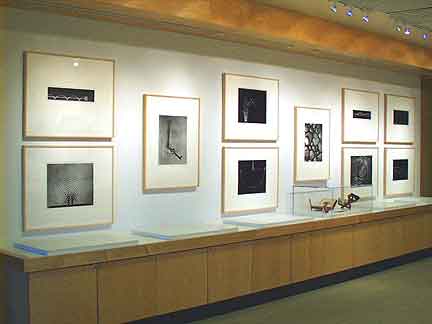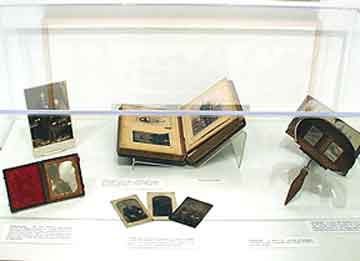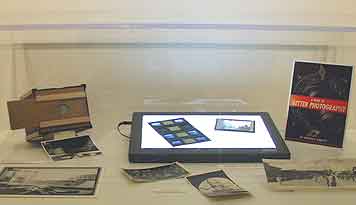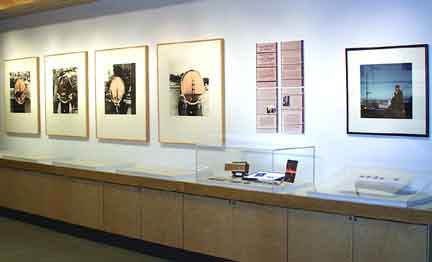Extracted
From an Archive
Photographic
Works From
The University
of Lethbridge Art Collection
March 21
- May 9, 2003
Helen Christou
Gallery

Curated by Don Gill
Assistant
Professor, Faculty of Fine Arts, U of L
Exhibition
Essay
andInstallation
Images (below)
| "Anyone
who reads detective stories knows that this genre places absolute faith
in the photograph. Photographs are the blackmailer's hole card and the
private eye's first piece of working evidence; whether the photographs
are true is rarely if ever questioned."
James
C.A. Kaufmann - Photographs and History: Flexible Illustrations Reading
into Photography - Pg 193 |
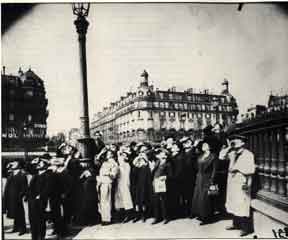
L'Eclipse,
Avril 1912, by Eugéne Atget, France (1857-1927)
|
How
do you look at photographs in an Art Gallery? Of course photographs and
photographic work can be art, but as you wander through a gallery or museum
you can view many photographs taken for completely utilitarian reasons
that are now being looked at in an art context. Collecting photographs
for exclusively aesthetic purposes separates them from whatever utilitarian
purposes they may have been created to serve and they become purely visual
objects.The Surrealist innovator Man Ray understood this when he used photographs
of Parisian street life by the documentary photographer Atget to illustrate
the Surrealist journal La Revolution Surrealiste. He considered Atget to
be a naïve and primitive photographer who took simple documents which
he then sold to artists. An important Surrealist principle was the discovery
of or the assigning of new meaning to images (or simply eliminating the
original meaning). |
| "There
are, of course many different kinds of archive, from those held in museums
to commercial or historical collections, or family albums. What they have
in common is the fact that they heap together images of very different
kinds and impose upon them a homogeneity that is a product of their very
existence within an archive."
Derrick
Price and Liz Wells - Thinking about Photography, a Critical Introduction
Pg 35 |
| When
we look at photographs we look at what the picture is: a dog, a cat, a
brother, sister, new car etc; or what it represents: war, famine, murder,
crime, success, celebrity and gossip etc. This is the subject or content
of the image. We see the photograph as a passage into another reality,
one that is not present but exists in memory or fantasy. We also look at
how the image is constructed: light, shadow, colour, contrast, arrangement
within the frame, line. This is the form, the visual structure of the image
that plays off the content of the image to make it visually interesting.
The critic and photographer John Szarkowski suggests:
"In
photography the pursuit of form has taken an unexpected course. In this
peculiar art, form and subject are defined simultaneously. Even more than
in the traditional arts, the two are inextricably tangled. Indeed they
are probably the same thing. Or if they are different, one might say that
a photograph's subject is not it's starting point but it's destination."
John
Szarkowski from William Eggleston's Guide |
| This
idea has been the impetus behind photographic collecting for the past quarter
century. In this view form and content are merged and construct a visual
meaning that requires no other context. This can be seen as the construction
of an archive of art. Examples of photography from the worlds of science,
social documentary, portraiture, fashion, advertising, war, journalism,
and politics appear in the company of photographic work that has no other
intent than art. The meaning of the work is constructed by the juxtaposition
of the images in an exhibition. For example, in this exhibition, you can
see the photographs of Berenice Abbott, which were produced with no other
idea than the illustration of scientific principles, in conjunction with
the art photographs of Suzy Lake, which are informed by nineteenth century
pseudo-scientific notions of composite photography and physiognomy. Iain
Baxter and Jeff Wall, two of Canada's best known artists, have made their
reputations as artists rather than photographers. Baxter uses photography
as one element in a many faceted studio practice and Wall, although his
work is photographic, is talked about in terms of painting and art history.
Through his use of the language of "history painting" in the construction
of his photographic works he has been credited with reinventing and reinvigorating
painting in the late twentieth century. |
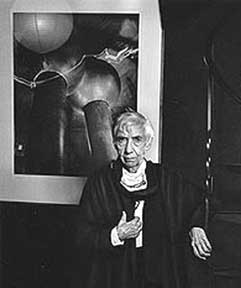
Berenice Abbott, ca. 1970, by Yousef
Karsh
|
"We
see this happening repeatedly, the anonymously rendered flash-lit murder
on the front page of the Daily News is appropriated by the Museum of Modern
Art as an exemplary moment in the career of the primitive freelance genius
Weegee, Hine prints that originally appeared in social work journals reappear
in biographical treatment of his career as an artist only to reappear in
labor union pamphlets."
Allan
Sekula - On the Invention of Photographic Meaning: Photography in Print
- Pg 457
-Don
Gill, Guest Curator
LLethbridge,
2003 |
|
